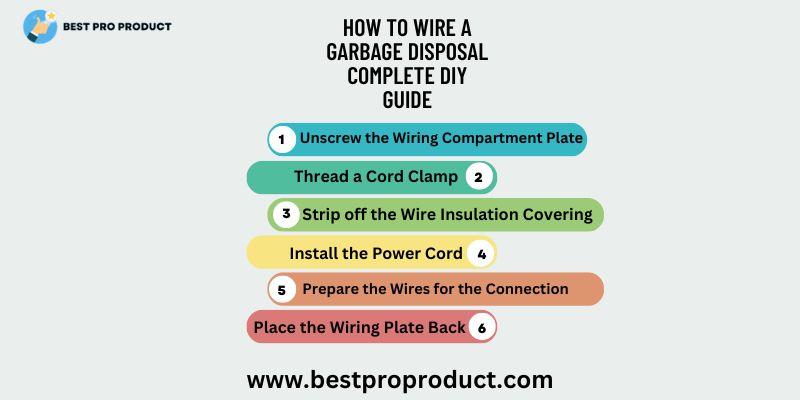You must not make the mistake of wiring the garbage disposal without proper guidance. Do you? It’s not too late as my step-by-step guide on How to Wire a Garbage Disposal will help you every bit to place each part and component like a pro.
To wire the disposal, unscrew the wiring plate, thread the clamp into the hole, and slide the power cord with its stripped ends from the hole to the compartment. Here you enjoin the hot with hot wire, neutral with neutral wire, and screw the ground wire to the disposal ground connection. The wiring is complete after tucking the plate back in place.
The article explains the details of wiring garbage disposal. In addition, what components and tools you need are mentioned to make the process easier.
How to Wire a Garbage Disposal with a Plug-in Cord?
Are you ready to wire your disposal? If yes, make all the arrangements, such as buying a power cord, keeping connectors, clamps, or garbage disposal wiring tools handy. It will take you a few minutes but let you do it without error.
Note: you will have to get a separate power cord if your garbage disposal is non-corded. But if yours’s have one, it is not essential.

Unscrew the Wiring Compartment Plate
It does not matter whether you are a newbie or a constant garbage disposal user, you must know that all the electrical settings take place beneath its body. So, turn the disposal unit upside down without wasting any time and look for the screwdriver to unscrew it.
Most garbage disposal covers comprise a few count screws from one or two. Also, place the plate with a screw aside, for it will be used after the procedure.
Thread a Cord Clamp
The next step is to hold the cord clamp and fit it into the hole beside the disposal wiring plate. The purpose is to make a support system for the power cord so that it remains in place. You must install the threaded end of the clamp to the length it tightens with a screwdriver, not too tight nor loose.
Strip off the Wire Insulation Covering
Another crucial step in wiring the disposal is to strip the wires using a wire stripper. You can skip the process if your power cord comes stripped. But if it is not, here is the way you can quickly do that using a wire stripper.
So, wrap off the 3/4 to 3/8 inches insulation covering of the wires. However, be careful of the wire material, such as stranded copper or solid copper because you must need a stripper in accordance.
Install the Power Cord
Let’s proceed forward by inserting the stripped ends of the power cord from the hole in the manner it appears to come out from the wiring compartment. As you have enough room for the wire in the electrical outlet to make the connection, tighten the clamp to the extent it holds the power cord intact without deforming it.
Prepare the Wires for the Connection
The wiring compartment bares all the wires load, and you get the combination of two different colors, white (neutral), black (hot), and a ground connection. Go on twisting the ends you stripped and connect the white cord to the white of the disposal using a wire connector. Also, do the same technique with both black cords.
You must wonder what about the ground wire? It is to be connected with the garbage disposal ground connection using a screwdriver. Also, do not forget to tighten the screw to ensure a secure connection.
There are situations when you get red color instead of black, treat it in the same way as you do with both blacks. However, if you notice the separate power cord no more highlights color differentiation, identify the wires from their appearance. Most neutral wires contain ridges, while hot wires are smoother with ground wire in the center.
Place the Wiring Plate Back
If you ensure setting all the connections to their compatible ones, tuck the wires into the compartment and hold back the plate you keep aside with its screws. Place it in the position and screw it to make it intact. You can also test the garbage disposal’s working by flipping the switch and running the cold water.
Can I Reuse Power Cord for Garbage Disposal?
Yes, you can reuse the power cord of the old garbage disposal for the new one. The only condition of utilizing it is to ensure that the wire is in good condition, which means not deformed nor compressed.
How Long Can a Garbage Disposal Cord Be?
As the sizes of the garbage disposal are different, so do the length of the wires to connect them. However, the average cord length you can keep in mind is 18 inches and 3 feet.
Corded VS Non-Corded Garbage Disposal Which One Best
Corded vs non-corded garbage disposals each have their merits, making the choice dependent on specific needs. The Corded garbage disposals have steady power and are reliable but need an outlet. Non-corded ones are more flexible to install but run on batteries, which may not be as reliable. Choose based on your kitchen setup and if you want convenience or constant performance. Pick what fits your needs best.
Bottom Line
Wiring a garbage disposal with a power cord is not a highly professional task, and you can easily take it as a DIY project. Even then, if you find it non-understandable, the article explains every possibility to help you whether it be connecting color-coordinated wires or stripping the cords up to a certain length. So, do you take the initiative to wire your garbage disposal yourself?
